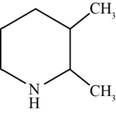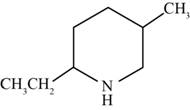
Concept explainers
Name the following:

(a)
Interpretation:
The given chemical structure has to be named.
Concept Introduction:
The nomenclature of the chemical structures:
A molecular formula describes the total number and types of the atoms in a molecule, whereas chemical structures describe the arrangement of atoms in a compound.
International Union of Pure and Applied Chemistry gave guidelines to write the chemical name of molecules. IUPAC names are totally different from common names because IUPAC names are applied at international level and it comprises suffix, prefix, numbers and other priority rules. The numbering starts from the side of substituent; if more than one substituent groups are present then these are cited alphabetically in the compound’s name.
Answer to Problem 21P
The name of the given compound is
Explanation of Solution
The structure of the given compound is shown below.

Figure 1
The compounds that comprise the saturated four membered rings are named as azetidines. The methyl substituent is present at the second carbon atom. Therefore, the name of the compound shown in figure is
(b)
Interpretation: The given chemical structure has to be named.
Concept Introduction:
The nomenclature of the chemical structures:
A molecular formula describes the total number and types of the atoms in a molecule, whereas chemical structures describe the arrangement of atoms in a compound.
International Union of Pure and Applied Chemistry gave guidelines to write the chemical name of molecules. IUPAC names are totally different from common names because IUPAC names are applied at international level and it comprises suffix, prefix, numbers and other priority rules. The numbering starts from the side of substituent; if more than one substituent groups are present then these are cited alphabetically in the compound’s name.
Answer to Problem 21P
The name of the given compound is
Explanation of Solution
The structure of the given compound is shown below.

Figure 2
The compounds that comprise the saturated six membered rings with a nitrogen atom are named as piperidines. The methyl substituents are present at the second and third carbon atoms. Therefore, the name of the compound shown in figure 2 is
(c)
Interpretation: The given chemical structure has to be named.
Concept Introduction:
The nomenclature of the chemical structures:
A molecular formula describes the total number and types of the atoms in a molecule, whereas chemical structures describe the arrangement of atoms in a compound.
International Union of Pure and Applied Chemistry gave guidelines to write the chemical name of molecules. IUPAC names are totally different from common names because IUPAC names are applied at international level and it comprises suffix, prefix, numbers and other priority rules. The numbering starts from the side of substituent; if more than one substituent groups are present then these are cited alphabetically in the compound’s name.
Answer to Problem 21P
The name of the given compound is
Explanation of Solution
The structure of the given compound is shown below.

Figure 3
The compounds that comprise the unsaturated four membered rings with a nitrogen atom are named as pyrroles. The chlorine substituent is present at the third carbon atom. Therefore, the name of the compound shown in figure 3 is
(d)
Interpretation:
The given chemical structure has to be named.
Concept Introduction:
The nomenclature of the chemical structures:
A molecular formula describes the total number and types of the atoms in a molecule, whereas chemical structures describe the arrangement of atoms in a compound.
International Union of Pure and Applied Chemistry gave guidelines to write the chemical name of molecules. IUPAC names are totally different from common names because IUPAC names are applied at international level and it comprises suffix, prefix, numbers and other priority rules. The numbering starts from the side of substituent; if more than one substituent groups are present then these are cited alphabetically in the compound’s name.
Answer to Problem 21P
The name of the given compound is
Explanation of Solution
The structure of the given compound is shown below.

Figure 4
The compounds that comprise saturated six membered rings with a nitrogen atom are named as piperidines. The ethyl and methyl substituents are present at the second and fifth carbon atoms respectively. Therefore, the name of the compound shown in figure is
Want to see more full solutions like this?
Chapter 19 Solutions
EBK ORGANIC CHEMISTRY
- Identify and provide a concise explanation of the concept of signal-to-noise ratio (SNR) in the context of chemical analysis. Provide specific examples.arrow_forwardIdentify and provide a concise explanation of a specific analytical instrument capable of detecting and quantifying trace compounds in food samples. Emphasise the instrumental capabilities relevant to trace compound analysis in the nominated food. Include the specific application name (eg: identification and quantification of mercury in salmon), outline a brief description of sample preparation procedures, and provide a summary of the obtained results from the analytical process.arrow_forwardIdentify and provide an explanation of what 'Seperation Science' is. Also describe its importance with the respect to the chemical analysis of food. Provide specific examples.arrow_forward
- 5. Propose a Synthesis for the molecule below. You may use any starting materials containing 6 carbons or less (reagents that aren't incorporated into the final molecule such as PhзP do not count towards this total, and the starting material can have whatever non-carbon functional groups you want), and any of the reactions you have learned so far in organic chemistry I, II, and III. Your final answer should show each step separately, with intermediates and conditions clearly drawn. H3C CH3arrow_forwardState the name and condensed formula of isooxazole obtained by reacting acetylacetone and hydroxylamine.arrow_forwardState the name and condensed formula of the isothiazole obtained by reacting acetylacetone and thiosemicarbazide.arrow_forward
- Provide the semi-developed formula of isooxazole obtained by reacting acetylacetone and hydroxylamine.arrow_forwardGiven a 1,3-dicarbonyl compound (R1-CO-CH2-CO-R2), indicate the formula of the compound obtaineda) if I add hydroxylamine (NH2OH) to give an isooxazole.b) if I add thiosemicarbazide (NH2-CO-NH-NH2) to give an isothiazole.arrow_forwardAn orange laser has a wavelength of 610 nm. What is the energy of this light?arrow_forward
- The molar absorptivity of a protein in water at 280 nm can be estimated within ~5-10% from its content of the amino acids tyrosine and tryptophan and from the number of disulfide linkages (R-S-S-R) between cysteine residues: Ε280 nm (M-1 cm-1) ≈ 5500 nTrp + 1490 nTyr + 125 nS-S where nTrp is the number of tryptophans, nTyr is the number of tyrosines, and nS-S is the number of disulfide linkages. The protein human serum transferrin has 678 amino acids including 8 tryptophans, 26 tyrosines, and 19 disulfide linkages. The molecular mass of the most dominant for is 79550. Predict the molar absorptivity of transferrin. Predict the absorbance of a solution that’s 1.000 g/L transferrin in a 1.000-cm-pathlength cuvet. Estimate the g/L of a transferrin solution with an absorbance of 1.50 at 280 nm.arrow_forwardIn GC, what order will the following molecules elute from the column? CH3OCH3, CH3CH2OH, C3H8, C4H10arrow_forwardBeer’s Law is A = εbc, where A is absorbance, ε is the molar absorptivity (which is specific to the compound and wavelength in the measurement), and c is concentration. The absorbance of a 2.31 × 10-5 M solution of a compound is 0.822 at a wavelength of 266 nm in a 1.00-cm cell. Calculate the molar absorptivity at 266 nm.arrow_forward

 Chemistry for Today: General, Organic, and Bioche...ChemistryISBN:9781305960060Author:Spencer L. Seager, Michael R. Slabaugh, Maren S. HansenPublisher:Cengage Learning
Chemistry for Today: General, Organic, and Bioche...ChemistryISBN:9781305960060Author:Spencer L. Seager, Michael R. Slabaugh, Maren S. HansenPublisher:Cengage Learning ChemistryChemistryISBN:9781305957404Author:Steven S. Zumdahl, Susan A. Zumdahl, Donald J. DeCostePublisher:Cengage Learning
ChemistryChemistryISBN:9781305957404Author:Steven S. Zumdahl, Susan A. Zumdahl, Donald J. DeCostePublisher:Cengage Learning Chemistry: An Atoms First ApproachChemistryISBN:9781305079243Author:Steven S. Zumdahl, Susan A. ZumdahlPublisher:Cengage Learning
Chemistry: An Atoms First ApproachChemistryISBN:9781305079243Author:Steven S. Zumdahl, Susan A. ZumdahlPublisher:Cengage Learning




